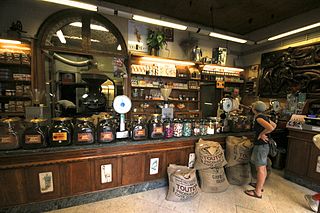
Cappuccino is an espresso-based coffee drink that is traditionally prepared with steamed milk including a layer of milk foam.

Espresso is a concentrated form of coffee produced by forcing hot water under high pressure through finely-ground coffee beans. Originating in Italy, espresso has become one of the most popular coffee-brewing methods worldwide. It is characterized by its small serving size, typically 25–30 ml, and its distinctive layers: a dark body topped with a lighter-colored foam called crema.

Italians are well known for their special attention to the preparation, the selection of the blends, and the use of accessories when creating many types of coffees. Many of the types of coffee preparation known today also have their roots here. The main coffee port in Italy is Trieste where there is also a lot of coffee processing industry. Italian coffee consumption, often espresso, is highest in the city of Trieste, with an average of 1500 cups of coffee per person per year. That is about twice as much as is usually drunk in Italy.

An espresso machine brews coffee by forcing pressurized water near boiling point through a "puck" of ground coffee and a filter in order to produce a thick, concentrated coffee called espresso. Multiple machine designs have been created to produce espresso. Several machines share some common elements, such as a grouphead and a portafilter. An espresso machine may also have a steam wand which is used to steam and froth liquids for coffee drinks such as cappuccino and caffè latte.

Philips Saeco S.p.A., or short Saeco, is an Italian manufacturer of manual, super-automatic and capsule espresso machines and other electrical goods with headquarters and factories in Gaggio Montano near Bologna.

Gaggia is an Italian manufacturer of coffee machines, especially espresso machines, in addition to small kitchen appliances. The company is owned by the Evoca Group.

La Marzocco, founded in 1927, Florence, by Giuseppe and Bruno Bambi, is an Italian company specializing in high-end espresso coffee machines. It is based in Scarperia, with branch offices worldwide.

Rancilio is an espresso machine manufacturer, founded in 1927 by Roberto Rancilio in Parabiago, Italy.

FAEMA primarily engaged in the production of espresso machines, was founded in 1945 by Carlo Ernesto Valente, in Milan, Italy. Faema was to become synonymous with the post-war production boom in Italy, by actively pursuing technological innovation as the company's driving force.
Antonio Suárez Vázquez was a professional road racing cyclist from Spain between 1956 and 1965. He is most famous for winning the overall title and the climbers classification at the 1959 Vuelta a España. In addition, Suarez won the points classification at the 1961 Vuelta and a career total of five stages at the Vuelta.
De'Longhi S.p.A. is an Italian small appliance manufacturer based in Treviso, Italy.

Joseph "Jef" Planckaert was a Belgian racing cyclist. He is seen as one of the best Belgian cyclists of the 1950s and 1960s.
The 16th Vuelta a España, a long-distance bicycle stage race and one of the three grand tours, was held from 26 April to 11 May 1961. It consisted of 16 stages covering a total of 2,856.5 km (1,774.9 mi), and was won by Angelino Soler of the Faema cycling team. Antonio Suárez won the points classification and Antonio Karmany won the mountains classification.
The E61 anthrax bomblet was an American biological sub-munition for the E133 cluster bomb. This anti-personnel weapon was developed in the early 1950s and carried 35 milliliters of anthrax spores or another pathogen.
Caffè crema refers to two different coffee drinks:

Faema was a professional cycling team that existed from 1955 to 1962. The team's main sponsor was espresso machine manufacturer Faema. In 1963, the Faema and Flandria teams were merged.

EMI was an Italian professional cycling team that existed from 1959 to 1961. In 1961, the team was renamed to VOV, and the Faema team changed its name to EMI for the 1961 Giro d'Italia. Charly Gaul won the general classification of the 1959 Giro d'Italia with the team.
The 1961 Liège–Bastogne–Liège was the 47th edition of the Liège–Bastogne–Liège cycle race and was held on 15 May 1961. The race started and finished in Liège. The race was won by Rik Van Looy of the Faema team.












